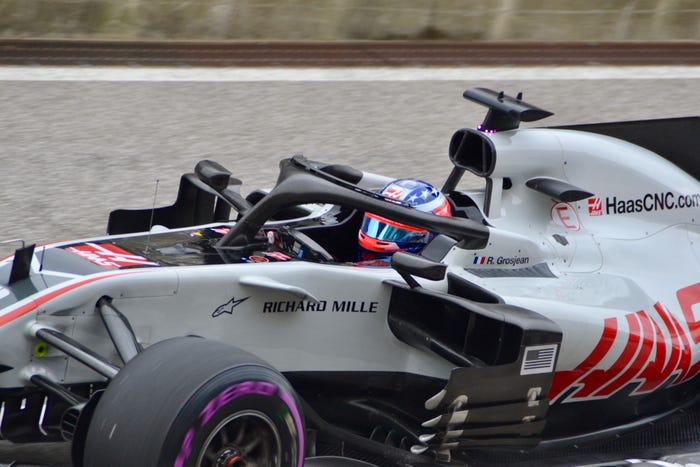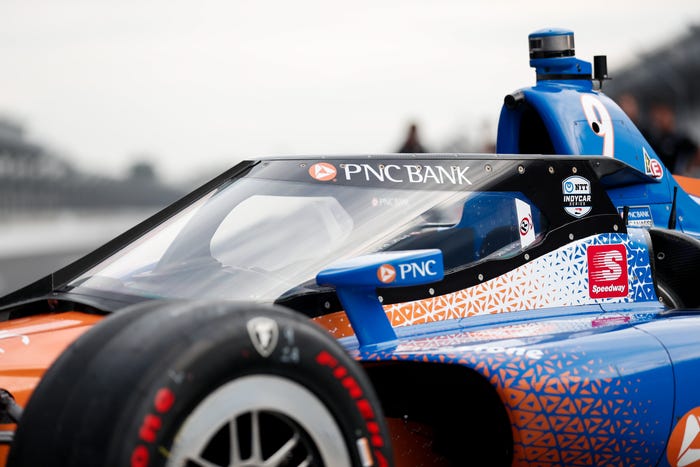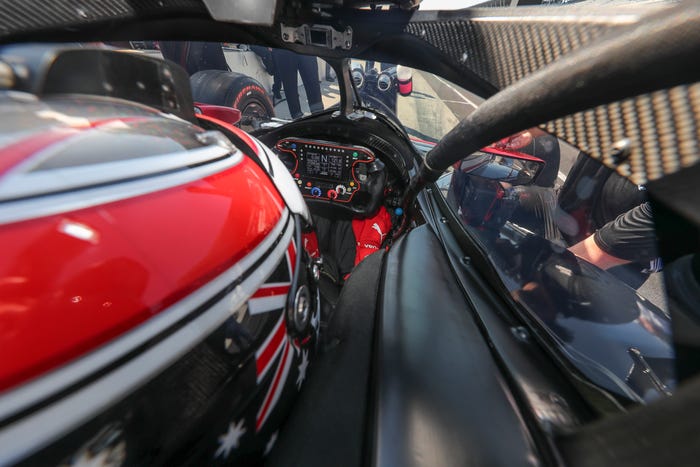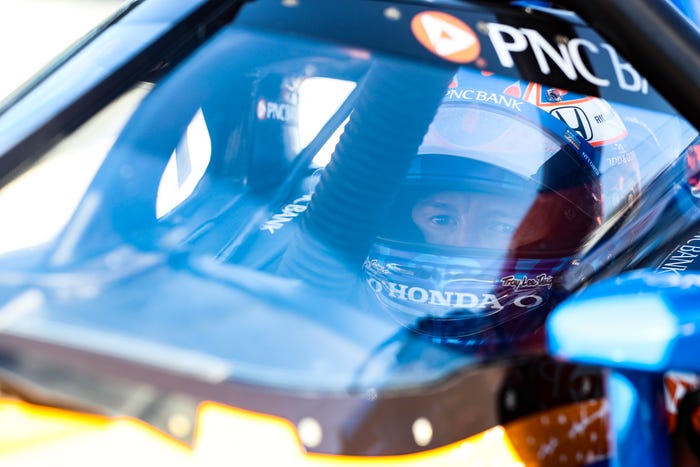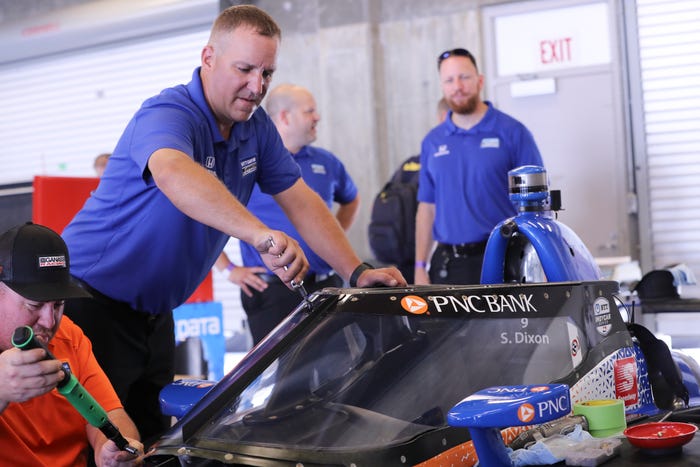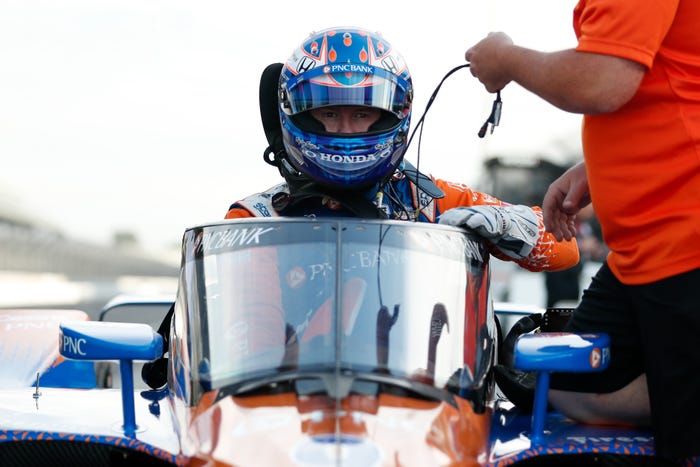The challenge is to protect drivers without obstructing their vision.
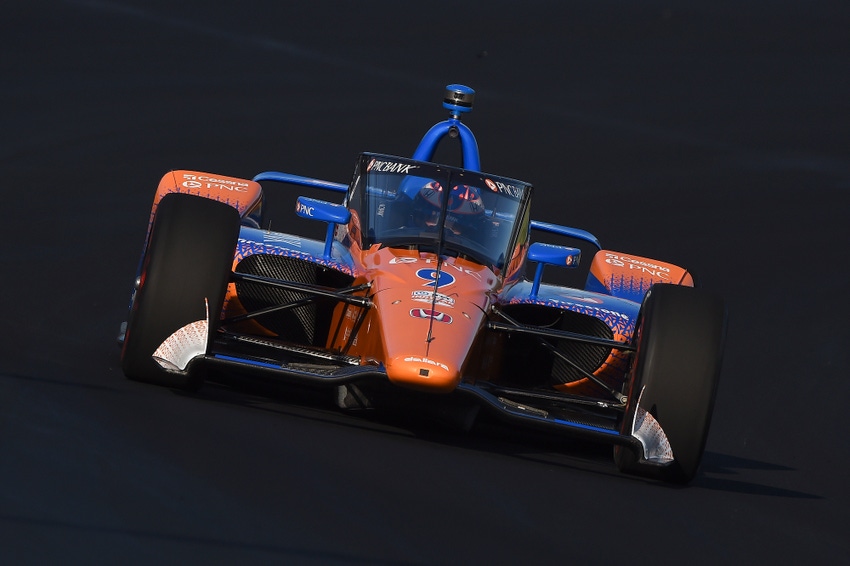
Open-cockpit racing preserves the gladiatorial feel of car racing in a way that closed-roof racing can’t capture. Even behind full-face helmets with reflective visors closed, fans can see the drivers at work behind the wheel, which helps draw a connection between the spectators and the athletes.
But open cockpits present risks to drivers, who can be struck in the head by debris when other drivers ahead have problems. Even worse, drivers can strike their heads on solid objects when they crash.
Some crashes will probably always be unsurvivable when the cars are going 220 mph or faster. But too many lesser incidents have seen drivers injured or killed. So racing engineers have pursued a solution to protect drivers.
|
Audi R8 Le Mans Prototype in the 24 Hours of Le Mans. (Image source: Audi) |
Sports car racing gave up on open cockpits following the 2001 testing fatality of Audi driver Michele Alboreto, who was killed when a tire failure caused his Audi R8 to flip over.
Open-wheel categories such as Formula 1 and IndyCar have endured injuries and fatalities, even when cars stayed upright. Ferrari driver Felipe Massa suffered a severe head injury when a spring fell off a car ahead during practice and struck Massa in the head. He recovered to continue his racing career, but IndyCar driver Justin Wilson wasn’t as fortunate. He died after a nosecone from a crashed car struck his head during a race in 2015.
In response, in 2018 Formula 1 mandated the Halo device, a protective structure atop the cockpit meant to shield the driver’s head from impacts. So far the Halo has demonstrated some benefit in crashes that looked like they might have been worse without it.
IndyCar initially preferred the idea of a windshield instead of the Halo’s bulky-looking structure, but found that the windshields tested deflected too much on impact.
|
The black Halo is plainly visible on the Haas F1 car of driver Romain Grosjean. (Image source: Dan Carney) |
The new solution, which will be in place on all cars in next year’s Indianapolis 500, is the Aeroscreen, created by Red Bull Advanced Technologies as an evolution of the concept it originally developed as a proposal for F1 in 2016. There are no carryover parts from that project, however, the company notes. The Aeroscreen looks like a Formula 1 Halo with a plexiglass windshield mounted on it, and in basic concept, though not in execution, that’s what it is.
Considering that the Halo has been on F1 cars for nearly two full seasons now, it might be easy to think that it would be a simple matter of adapting that known design to IndyCars. But there are less obvious complications that prevent that according to Tino Belli, director of aerodynamic development for IndyCar.
The first is that IndyCar races on ovals, where many crashes see the drivers smashing into the chain link retaining fence outside the track. The F1 Halo is designed primarily to protect from forward impacts, and it swoops downward as it wraps around the driver’s head, leaving them more visible to fans.
IndyCar’s Aeroscreen has a similar-looking structure, but its structure stays higher than the top of the driver’s helmet all the way around. This provides protection in the case of incidents like Robert Wickens' 2018 crash at the Pocono Raceway, which left him partially paralyzed as the result of neck injuries from a crash into the catch fence.
“We need to protect our drivers’ heads from getting up against the fence,” explained Belli.
|
The Aeroscreen tested on Scott Dixon's IndyCar. (Image source: IndyCar) |
And the windshield is there to guard against small debris from striking the driver in the face. This is more important for IndyCar because the average speeds on ovals are much higher than those on the road course-only F1. The resulting frequent high-speed impacts pulverize cars, producing a rain of small debris on close-following traffic.
“Debris that weighs grams, at 100 mph, if it hits you on the head, it gives you a concussion,” Belli observed. And driving through a storm of shattered carbon fiber and metal bits, the fear was that some of this could deflect downward off a Halo’s upper structure and strike a driver in their unprotected torso.
F1’s Halo is made of tubular titanium to minimize the amount of mass added to the top of the car and reduce its impact on the center of gravity. IndyCar’s Aeroscreen structure is also titanium for the same reason, but it is 3D-printed in box section, providing a flat surface for attaching the windshield rather than the curved surface of the Halo’s tubular structure.
The structure is printed in five pieces by Austria’s Pankl Racing Systems and then meticulously welded together by expert welders. Pankl was familiar to IndyCar as the producer of hubs, driveshafts, and wheel nuts and the company had the 3D printing capability. However, even Pankl had to modify its printers to be able to create the Aeroscreen’s large pieces, according to Belli.
|
The carbon fiber trim pieces of the Aeroscreen on Will Power's car are key to controlling cockpit buffeting. (Image source: IndyCar) |
The Aeroscreen is trimmed in carbon fiber aerodynamic pieces that are made by Aerodyne Engineering, Inc. in Indianapolis. The company is already contracted to provide the approved aerodynamic update parts to IndyCar teams and it is a certified repair station for damaged carbon fiber, so it is a natural participant in the Aeroscreen project, said Belli.
The windshield itself is a 3/8-inch 2-layer polyester screen made in two pieces. “Bending polyester to a shape, they have to be correct,” Belli noted. “You have to make quite a few tools to make two windshields a week, and there is a reasonable scrap rate. They check each layer and optical quality is very tightly controlled.”
Indeed, so tightly that the original, unnamed supplier has been replaced by a new, also unnamed, supplier.
In addition to the necessity of mounting the windshield, the Aeroscreen’s structure also differs from that of the F1 Halo because the structure around the cockpits of the cars is different. IndyCars are built so that the roll hoop behind the driver’s head is the primary load structure, while F1 builds strength into the area around the cockpit.
The Halo mounts to the top of the cockpit opening, but the Aeroscreen attaches at the rear, to the roll hoop’s structure, according to Belli. Both are rated to withstand 150 kilonewtons of force (33,721 lbs.), though Belli says he is keen to test the Aeroscreen to failure because he expects it will significantly exceed that minimum rating.
The entire thing adds 60 lbs. to the car’s weight. And because it is mounted high on the chassis, the Aeroscreen raises the car’s center of gravity by 15mm and moves it toward the front of the car. This puts additional load on the car’s front tires, so the development work had to be done in consultation with series tire supplier Firestone to ensure suitable race tires for next season.
|
The view through Will Power's Aeroscreen. (Image source: IndyCar) |
It also affects airflow over the car. This needs to be understood, not only for performance reasons, but also for crash safety. Modern IndyCar aerodynamics are carefully tuned to provide stability during spins, to discourage the car from flipping over, and this characteristic needed to be preserved, Belli explained.
Then there’s the matter of airflow inside the cockpit. IndyCar’s computational fluid dynamics modeling only applied to the flow of air over the outside of the car and didn’t provide any information on the airflow to the driver. This is critical for a couple reasons. One is to ensure acceptable pressure on the driver’s helmet, and the other is the need to provide cooling airflow during hot weather.
The challenge is that while the screen deflects the air that would strike the front of the driver’s helmet, the air hitting the back of the cockpit and pushing the driver’s head forward is still present. Only now it isn’t offset by the previous pressure from the front, so the airflow pushing forward needed to be controlled. “We had to shape the back of the structure carefully to reduce that,” Belli said. “We designed it in CFD and then track tested it to verify.”
And the teams will experiment with ducts that are being added to the access cover to the car’s front dampers to help bring fresh air to the cockpit, which is especially critical for hot summer street races that make up about one-third of IndyCar’s racing calendar. "Cooling for super speedways will be sufficient,” stated Belli. “But for boiling hot days in Detroit or Toronto, we weren’t sure.”
Preserving visibility through the windshield over a race distance is another matter. The Aeroscreen lacks windshield washers or wipers and doesn’t have a defogger to blow warm air on the inside during rain races.
The solution to the former is to add a stack of plastic tear-off covers similar to the ones drivers use on their helmet visors already. When the car stops for fuel or tires the team can simply rip off the top-layer tear off to clean up the driver’s view. And because there’s no hot air to defog the windshield like there is in your street car, the Aeroscreen is electrically heated, like your car’s rear window defroster, to keep it clear in damp, chilly conditions.
|
Scott Dixon peers through his car's Aeroscreen during track testing. (Image source: IndyCar) |
In case of a crash, the Aeroscreen is not expected to introduce a hindrance to the driver getting out of the car, or, in the case of a severe injury, being quickly and safely extracted by the emergency crew. In testing so far with dummies, safety crews actually found it easier to pull the driver out of the cockpit because the Aeroscreen’s structure gave them something to brace against while pulling, according to Belli. “They believe it will be less of a hindrance rather than more of a hindrance,” he said.
The concern is that in an upside-down car, the structure and windshield could obstruct a driver from scrambling out. So far, that hasn’t been the case with F1’s Halo and it is hoped that will be the situation with the Aeroscreen. Further, having that structure in place should make the car more prone to tip to one side or the other if it flips, rather than resting flat on its top, said Belli. “The odds of being completely upside down are reduced,” he explained.
|
Scott Dixon's crew installing the Aeroscreen on his car. (Image source: IndyCar) |
In everyday use, the teams will find the Aeroscreen a hindrance in servicing the cars, he conceded. “Working on the cars with the windscreen on is a real pain in the ass,” Belli said. “But the windscreen and frame can be removed in about 15 minutes. And that time will probably come down to 10 minutes with practice, so they will be able to take it off between track sessions if they want to.”
If the Aeroscreen is in the way of removing an injured driver after a crash, the safety team has practiced cutting one off if necessary and has found that process takes about a minute, Belli reported.
IndyCar drivers have been testing the Aeroscreen to get experience and suggest improvements. So far they say they are satisfied with its basic function. Driver Scott Dixon’s first observation was the reduced wind noise behind the windshield. “I can hear my radio for a change,” he said during a press conferencing following a day-long track test of the device. “Normally, I can’t hear that. So that’s kind of nice.”
His colleague Will Power noted some reflections off the bodywork on the back side of the windshield that the team can address with anti-reflective finishes in key spots. Similarly, both drivers found that the cockpit airflow will need to be customized to each driver’s preferences, with the teams adjusting the vents and airflow deflectors.
|
Scott Dixon slides into his car's cockpit, behind the Aeroscreen. (Image source: IndyCar) |
Ultimately, both drivers reported acceptable visibility through the Aeroscreen and that they found it didn’t interfere with their cars’ handling. “The [impact on aerodynamic drag] was smaller than what I thought it was going to be,” said Power. “It was almost neutral.” However, the added profile seems sure to increase the car’s sensitivity to buffeting from side gusts on windy days, he added.
“Honestly, I think it is going to be a net zero [performance difference],” said Dixon.
Dixon pointed out that the Aeroscreen complicated the process of clambering into the cockpit and cinching the restraining belts tight. “I think you’re going to have to get in the car a little earlier,” he said. “It does take a little longer. But getting out was fine, actually,”
In total, the Aeroscreen will extract an insignificant sacrifice from drivers and teams for the expected safety benefits. “You think about it, when you’ve driven it for a day, you’re going to feel naked without it," Power said.
Dan Carney is a Design News senior editor, covering automotive technology, engineering and design, especially emerging electric vehicle and autonomous technologies.
About the Author(s)
You May Also Like


